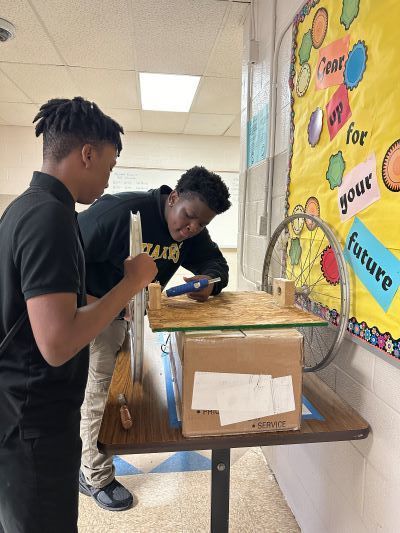Hanes Magnet Middle School Latin classes and Project Lead The Way teamed up for a unique display of history and engineering when they drove chariots that they built themselves.
 Chariots are some of the earliest known vehicles in history, showing up in records shortly after the invention of the wheel. Their relatively simple designs and physics make them an interesting project for aspiring engineers who are getting a grasp on what a vehicle needs to function. Latin Teacher Leighann Johnson felt that partnering with PLTW would be a rare and valuable chance to translate something from Latin history into a hands-on project.
Chariots are some of the earliest known vehicles in history, showing up in records shortly after the invention of the wheel. Their relatively simple designs and physics make them an interesting project for aspiring engineers who are getting a grasp on what a vehicle needs to function. Latin Teacher Leighann Johnson felt that partnering with PLTW would be a rare and valuable chance to translate something from Latin history into a hands-on project.
“We’re lucky enough to have a lot of unique opportunities at our school because of Project Lead The Way, so why not make the most of them?” Johnson said.
 PLTW is all about project-based learning that inspires students to take curriculum into their own hands and build something unique. In this case, students studied how chariots work and what their most important components are, drafted blueprints based on those specifications, and constructed models using their designs. Most groups made smaller models using LEGO, but by using donated plywood and bike tires, a few were able to make life-sized chariots.
PLTW is all about project-based learning that inspires students to take curriculum into their own hands and build something unique. In this case, students studied how chariots work and what their most important components are, drafted blueprints based on those specifications, and constructed models using their designs. Most groups made smaller models using LEGO, but by using donated plywood and bike tires, a few were able to make life-sized chariots.
By the time the project culminated in students driving their chariots around the school track on Wednesday morning, PLTW Teacher Samuel Ball was pleased with the results. There was a learning curve in getting started with a project this novel, but he expects that it will go smoother with each passing year. The most important part was that students rose to the occasion and produced results that they could be proud of.
“One of my favorite things about this class is how much choice they have in what they do and how they do it,” Ball said. “They get to be creative and use their talents, and that gets them more comfortable with what they’re doing. When they’re comfortable, they learn better.”
 As a STEM magnet school, Hanes prepares its scholars for future-ready careers as engineers, mathematicians, software developers, inventors, and much more. Success in any of those fields requires ingenuity and a willingness to think outside the box. Ventures like the chariot project help foster that essential spark of scientific curiosity, and the students who participated are already feeling more inspired than before.
As a STEM magnet school, Hanes prepares its scholars for future-ready careers as engineers, mathematicians, software developers, inventors, and much more. Success in any of those fields requires ingenuity and a willingness to think outside the box. Ventures like the chariot project help foster that essential spark of scientific curiosity, and the students who participated are already feeling more inspired than before.
“Building has never really been my thing, so this was a challenge for me, but it got better over time,” said Eighth Grader Lonnie Little. “I’d say I’m at least mildly confident now.”

